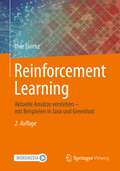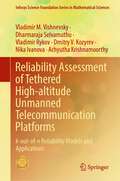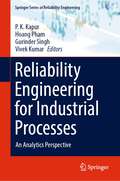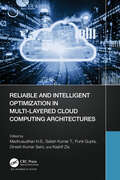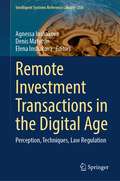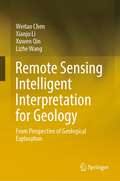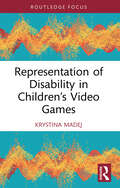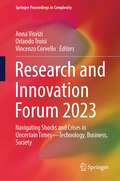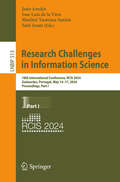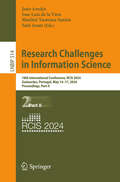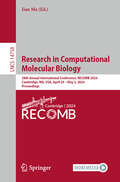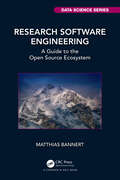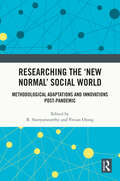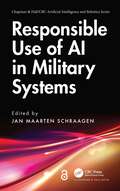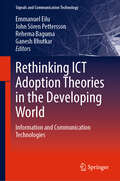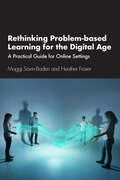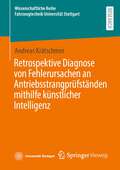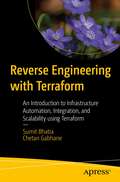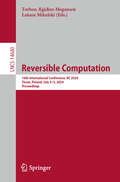- Table View
- List View
Reinforcement Learning: Aktuelle Ansätze verstehen – mit Beispielen in Java und Greenfoot
by Uwe LorenzIn uralten Spielen wie Schach oder Go können sich die brillantesten Spieler verbessern, indem sie die von einer Maschine produzierten Strategien studieren. Robotische Systeme üben ihre Bewegungen selbst. In Arcade Games erreichen lernfähige Agenten innerhalb weniger Stunden übermenschliches Niveau. Wie funktionieren diese spektakulären Algorithmen des bestärkenden Lernens? Mit gut verständlichen Erklärungen und übersichtlichen Beispielen in Java und Greenfoot können Sie sich die Prinzipien des bestärkenden Lernens aneignen und in eigenen intelligenten Agenten anwenden. Greenfoot (M.Kölling, King’s College London) und das Hamster-Modell (D.Bohles, Universität Oldenburg) sind einfache, aber auch mächtige didaktische Werkzeuge, die entwickelt wurden, um Grundkonzepte der Programmierung zu vermitteln. Wir werden Figuren wie den Java-Hamster zu lernfähigen Agenten machen, die eigenständig ihre Umgebung erkunden. Die zweite Auflage enthält neue Themen wie "Genetische Algorithmen" und "Künstliche Neugier" sowie Korrekturen und Überarbeitungen.
Reliability Assessment of Tethered High-altitude Unmanned Telecommunication Platforms: k-out-of-n Reliability Models and Applications (Infosys Science Foundation Series)
by Vladimir M. Vishnevsky Dharmaraja Selvamuthu Vladimir Rykov Dmitry V. Kozyrev Nika Ivanova Achyutha KrishnamoorthyThis book provides a systematic presentation of the major results in the field of the theory of k-out-of-n systems obtained in recent years and their applications for the reliability assessment of high-altitude unmanned platforms. Mathematical models, methods, and algorithms, presented in the book, will make a significant contribution to the development of reliability theory and the theoretical foundations of unmanned UAV-based aerial communications networks in the framework of the concept of creating the 5G and beyond networks. The book gives a description of new mathematical methods and approaches (based on decomposable semi-regenerative processes, simulation and machine learning methods, and inventory models) to the study of the complex k-out-of-n systems, which makes it possible to carry out numerical calculations of reliability indicators. Organized into five chapters, each chapter begins with a summary of the main definitions andresults contained in the chapter. The content of this book is based on the original results developed by the authors, many of which appear for the first time in book form.
Reliability Engineering for Industrial Processes: An Analytics Perspective (Springer Series in Reliability Engineering)
by P. K. Kapur Hoang Pham Gurinder Singh Vivek KumarThis book explores how transformative changes driven by the new-age economy can bring about improvements in a company's engineering and manufacturing capabilities. The new-age economy is driven by advanced engineering and manufacturing practices, processes, and technologies, including the Internet of Things (IoT), Cloud Computing, Blockchain, Artificial Intelligence, Robotics, Cyber-Physical Systems (CPS), and Internet-enabled systems to automate industrial processes. Today's business dynamics are governed by uncertainties, disruptions, complexities, and ambiguities that demand quicker and more intelligent decisions. These changes could relate a renaissance in the company's engineering and manufacturing capabilities. To sustain these volatile and ever-changing business dynamics, Industry 4.0 and 5.0 have revolutionized how organizations operate and make intelligent business decisions. Moreover, the extensive role of business analytics has overcome the limitations ofclassical computing through new technologies and intelligent computing methodologies. Over the past few years, much emphasis has been given to investing in developing hardware and programming frameworks for achieving computational intelligence using fuzzy logic, evolutionary computation, neural networks, probabilistic methods, and learning theory. Within this frame of reference, the reliability, quality, and maintenance of complex industrial and manufacturing systems are essential for organizations to utilize them successfully for informed decisions. This book focuses on studies that provide new solutions for system reliability, quality, security, and maintainability using quantitative and qualitative research. It emphasizes developments and problems in systems engineering management, systems integration, software and hardware engineering, and the development process.
Reliable and Intelligent Optimization in Multi-Layered Cloud Computing Architectures
by Madhusudhan H. S. Satish Kumar T. Punit Gupta Dinesh Kumar Saini Kashif ZiaOne of the major developments in the computing field has been cloud computing, which enables users to do complicated computations that local devices are unable to handle. The computing power and flexibility that have made the cloud so popular do not come without challenges. It is particularly challenging to decide which resources to use, even when they have the same configuration but different levels of performance because of the variable structure of the available resources. Cloud data centers can host millions of virtual machines, and where to locate these machines in the cloud is a difficult problem. Additionally, fulfilling optimization needs is a complex problem.Reliable and Intelligent Optimization in Multi-Layered Cloud Computing Architectures examines ways to meet these challenges. It discusses virtual machine placement techniques and task scheduling techniques that optimize resource utilization and minimize energy consumption of cloud data centers. Placement techniques presented can provide an optimal solution to the optimization problem using multiple objectives. The book focuses on basic design principles and analysis of virtual machine placement techniques and task allocation techniques. It also looks at virtual machine placement techniques that can improve quality-of-service (QoS) in service-oriented architecture (SOA) computing. The aims of virtual machine placement include minimizing energy usage, network traffic, economical cost, maximizing performance, and maximizing resource utilization. Other highlights of the book include: Improving QoS and resource efficiency Fault-tolerant and reliable resource optimization models A reactive fault tolerance method using checkpointing restart Cost and network-aware metaheuristics. Virtual machine scheduling and placement Electricity consumption in cloud data centers Written by leading experts and researchers, this book provides insights and techniques to those dedicated to improving cloud computing and its services.
Reliable and Intelligent Optimization in Multi-Layered Cloud Computing Architectures
One of the major developments in the computing field has been cloud computing, which enables users to do complicated computations that local devices are unable to handle. The computing power and flexibility that have made the cloud so popular do not come without challenges. It is particularly challenging to decide which resources to use, even when they have the same configuration but different levels of performance because of the variable structure of the available resources. Cloud data centers can host millions of virtual machines, and where to locate these machines in the cloud is a difficult problem. Additionally, fulfilling optimization needs is a complex problem.Reliable and Intelligent Optimization in Multi-Layered Cloud Computing Architectures examines ways to meet these challenges. It discusses virtual machine placement techniques and task scheduling techniques that optimize resource utilization and minimize energy consumption of cloud data centers. Placement techniques presented can provide an optimal solution to the optimization problem using multiple objectives. The book focuses on basic design principles and analysis of virtual machine placement techniques and task allocation techniques. It also looks at virtual machine placement techniques that can improve quality-of-service (QoS) in service-oriented architecture (SOA) computing. The aims of virtual machine placement include minimizing energy usage, network traffic, economical cost, maximizing performance, and maximizing resource utilization. Other highlights of the book include: Improving QoS and resource efficiency Fault-tolerant and reliable resource optimization models A reactive fault tolerance method using checkpointing restart Cost and network-aware metaheuristics. Virtual machine scheduling and placement Electricity consumption in cloud data centers Written by leading experts and researchers, this book provides insights and techniques to those dedicated to improving cloud computing and its services.
Remote Investment Transactions in the Digital Age: Perception, Techniques, Law Regulation (Intelligent Systems Reference Library #250)
by Agnessa Inshakova Denis Matytsin Elena InshakovaThe book contains the results of the best research developments obtained during the implementation of major scientific events organized and carried out with the financial support of the Russian Science Foundation and the President of the Russian Federation.The scientific novelty of the work lies in the fact that for the first time at the level of Russian and international interdisciplinary social and humanitarian sciences, primarily economic and legal, firstly, philosophical concepts and regulatory legal approaches to the regulation of remote investment transactions have been studied; secondly, a set of economic and legal conditions and means of harmonizing and observing the mutual interests of participants in remote investment transactions has been developed and proposed in order to prevent and minimize potential conflicts between the parties; thirdly, the current state and international regulation of investment transactions concluded and executed on Internet platforms was critically assessed; fourthly, a system of guarantees and protection of the rights of participants in remote investment transactions is proposed, including special contractual structures and an economic and legal model for the proper fulfillment of obligations.Measures are substantiated to expand and increase the intensity of the national investment turnover based on the improvement of the current legislation regulating investments through remote digital technologies in the Internet space, which provided a solution to the world scientific problem of great socioeconomic and economic importance. The book is designed for a wide target audience—scientists of different generations, different disciplinary and industry affiliations. Among them are young researchers, as well as scientists who have received recognition from the world scientific community, studying the socioeconomic, managerial, and legal consequences of the emergence and spread of digital technologies in the field of investment. Readers can be all individuals and legal entities interested in the development of digital technologies in the field of investment.
Remote Sensing Intelligent Interpretation for Geology: From Perspective of Geological Exploration
by Weitao Chen Xianju Li Xuwen Qin Lizhe WangThis book presents the theories and methods for geology intelligent interpretation based on deep learning and remote sensing technologies. The main research subjects of this book include lithology and mineral abundance. This book focuses on the following five aspects: 1. Construction of geology remote sensing datasets from multi-level (pixel-level, scene-level, semantic segmentation-level, prior knowledge-assisted, transfer learning dataset), which are the basis of geology interpretation based on deep learning. 2. Research on lithology scene classification based on deep learning, prior knowledge, and remote sensing. 3. Research on lithology semantic segmentation based on deep learning and remote sensing. 4. Research on lithology classification based on transfer learning and remote sensing. 5. Research on inversion of mineral abundance based on the sparse unmixing theory and hyperspectral remote sensing. The book is intended for undergraduate and graduate students who are interested in geology, remote sensing, and artificial intelligence. It is also used as a reference book for scientific and technological personnel of geological exploration.
Representation of Disability in Children’s Video Games (Routledge Research in Disability and Media Studies)
by Krystina MadejRepresentation of Disability in Children’s Video Games looks at how children’s engagement with characters and stories in video games helps create the perception of disability they have as teens and adults. Drawing on child development theory supported by neuroscience, the book shows how the scaffold of information, the schema, adults have of disability is first created at a very young age as they interact through game play with characters with disabilities. Positing that early video game play experiences should provide exposure to narrative schemas that add understanding and help create meaning about the disability represented, the book presents how such representation in children’s video games maps against cognitive development, and the psychomotor and cognitive needs and abilities of children ages 3 to 12. Close reading of over 40 PEGI 3 and PEGI 7 (ESRB E, 10+) games and analysis of games as diverse as Backyard Baseball and Sly Cooper helped define broad categories of representation: representation can be cosmetic, providing exposure but not gameplay utility; it can be incidental, used as a device that provides purpose for the narrative; or it can more authentically represent the disability as integral to the character and their life. The book provides readers with an overview of contemporary games that betters their understanding of how children’s games present disability and how children create their perceptions through interaction with characters and stories. This book will be of interest to academics and students of game studies, in particular topics such as behavioural science, ethics, and HCI, as well as sociology, communications, and digital media.
Representation of Disability in Children’s Video Games (Routledge Research in Disability and Media Studies)
by Krystina MadejRepresentation of Disability in Children’s Video Games looks at how children’s engagement with characters and stories in video games helps create the perception of disability they have as teens and adults. Drawing on child development theory supported by neuroscience, the book shows how the scaffold of information, the schema, adults have of disability is first created at a very young age as they interact through game play with characters with disabilities. Positing that early video game play experiences should provide exposure to narrative schemas that add understanding and help create meaning about the disability represented, the book presents how such representation in children’s video games maps against cognitive development, and the psychomotor and cognitive needs and abilities of children ages 3 to 12. Close reading of over 40 PEGI 3 and PEGI 7 (ESRB E, 10+) games and analysis of games as diverse as Backyard Baseball and Sly Cooper helped define broad categories of representation: representation can be cosmetic, providing exposure but not gameplay utility; it can be incidental, used as a device that provides purpose for the narrative; or it can more authentically represent the disability as integral to the character and their life. The book provides readers with an overview of contemporary games that betters their understanding of how children’s games present disability and how children create their perceptions through interaction with characters and stories. This book will be of interest to academics and students of game studies, in particular topics such as behavioural science, ethics, and HCI, as well as sociology, communications, and digital media.
Research and Innovation Forum 2023: Navigating Shocks and Crises in Uncertain Times—Technology, Business, Society (Springer Proceedings in Complexity)
by Anna Visvizi Orlando Troisi Vincenzo CorvelloThis book features research presented and discussed during the Research & Innovation Forum (Rii Forum) 2023. As such, this book offers a unique insight into emerging topics, issues and developments pertinent to the fields of technology, innovation and education and their social impact. Papers included in this book apply inter- and multi-disciplinary approaches to query such issues as technology-enhanced teaching and learning, smart cities, information systems, cognitive computing and social networking. What brings these threads of the discussion together is the question of how advances in computer science—which are otherwise largely incomprehensible to researchers from other fields—can be effectively translated and capitalized on so as to make them beneficial for society as a whole. In this context, Rii Forum and Rii Forum proceedings offer an essential venue where diverse stakeholders, including academics, the think tank sector and decision-makers, can engage in a meaningful dialogue with a view to improving the applicability of advances in computer science.
Research Challenges in Information Science: 18th International Conference, RCIS 2024, Guimarães, Portugal, May 14–17, 2024, Proceedings, Part I (Lecture Notes in Business Information Processing #513)
by João Araújo Jose Luis de la Vara Maribel Yasmina Santos Saïd AssarThis book constitutes the proceedings of the 18th International Conference on Research Challenges in Information Sciences, RCIS 2024, which took place in Guimarães, Portugal, during May 2024. The scope of RCIS is summarized by the thematic areas of information systems and their engineering; user-oriented approaches; data and information management; business process management; domain-specific information systems engineering; data science; information infrastructures, and reflective research and practice. The 25 full papers, 12 Forum and 5 Doctoral Consortium papers included in these proceedings were carefully reviewed and selected from 100 submissions. They were organized in topical sections as follows: Part I: Data and information management; conceptual modelling and ontologies; requirements and architecture; business process management; data and process science; security; sustainability; evaluation and experience studies Part II: Forum papers; doctoral consortium papers.
Research Challenges in Information Science: 18th International Conference, RCIS 2024, Guimarães, Portugal, May 14–17, 2024, Proceedings, Part II (Lecture Notes in Business Information Processing #514)
by João Araújo Jose Luis de la Vara Maribel Yasmina Santos Saïd AssarThis book constitutes the proceedings of the 18th International Conference on Research Challenges in Information Sciences, RCIS 2024, which took place in Guimarães, Portugal, during May 2024. The scope of RCIS is summarized by the thematic areas of information systems and their engineering; user-oriented approaches; data and information management; business process management; domain-specific information systems engineering; data science; information infrastructures, and reflective research and practice. The 25 full papers, 12 Forum and 5 Doctoral Consortium papers included in these proceedings were carefully reviewed and selected from 100 submissions. They were organized in topical sections as follows: Part I: Data and information management; conceptual modelling and ontologies; requirements and architecture; business process management; data and process science; security; sustainability; evaluation and experience studies Part II: Forum papers; doctoral consortium papers.
Research in Computational Molecular Biology: 28th Annual International Conference, RECOMB 2024, Cambridge, MA, USA, April 29–May 2, 2024, Proceedings (Lecture Notes in Computer Science #14758)
by Jian MaThis book constitutes the proceedings of the 28th Annual International Conference on Research in Computational Molecular Biology, RECOMB 2024, held in Cambridge, MA, USA, during April 29–May 2, 2024. The 57 full papers included in this book were carefully reviewed and selected from 352 submissions. They were organized in topical sections as follows: theoretical and foundational algorithm contributions and more applied directions that engage with new technologies and intriguing biological questions.
Research Software Engineering: A Guide to the Open Source Ecosystem (Chapman & Hall/CRC Data Science Series)
by Matthias BannertResearch Software Engineering: A Guide to the Open Source Ecosystem strives to give a big-picture overview and an understanding of the opportunities of programming as an approach to analytics and statistics. The book argues that a solid "programming" skill level is not only well within reach for many but also worth pursuing for researchers and business analysts. The ability to write a program leverages field-specific expertise and fosters interdisciplinary collaboration as source code continues to become an important communication channel. Given the pace of the development in data science, many senior researchers and mentors, alongside non-computer science curricula lack a basic software engineering component. This book fills the gap by providing a dedicated programming-with-data resource to both academic scholars and practitioners.Key Features overview: breakdown of complex data science software stacks into core components applied: source code of figures, tables and examples available and reproducible solely with license cost-free, open source software reader guidance: different entry points and rich references to deepen the understanding of selected aspects
Research Software Engineering: A Guide to the Open Source Ecosystem (Chapman & Hall/CRC Data Science Series)
by Matthias BannertResearch Software Engineering: A Guide to the Open Source Ecosystem strives to give a big-picture overview and an understanding of the opportunities of programming as an approach to analytics and statistics. The book argues that a solid "programming" skill level is not only well within reach for many but also worth pursuing for researchers and business analysts. The ability to write a program leverages field-specific expertise and fosters interdisciplinary collaboration as source code continues to become an important communication channel. Given the pace of the development in data science, many senior researchers and mentors, alongside non-computer science curricula lack a basic software engineering component. This book fills the gap by providing a dedicated programming-with-data resource to both academic scholars and practitioners.Key Features overview: breakdown of complex data science software stacks into core components applied: source code of figures, tables and examples available and reproducible solely with license cost-free, open source software reader guidance: different entry points and rich references to deepen the understanding of selected aspects
Researching the ‘New Normal’ Social World: Methodological Adaptations and Innovations Post-Pandemic
by R. Sooryamoorthy Vivian OjongThis edited volume focuses on the changing research methodologies in social science research, prompted by the new social world shaped by the pandemic. It explores adaptations and developments to meet the demands of transforming social circumstances and showcases innovative alternative approaches. Featuring a range of international and interdisciplinary contributors who discuss the context of social science research in the "new normal", the book sets out the need to redesign research to address present-day challenges for the post-pandemic. Chapters share methodological innovations and demonstrate how applicable these new and adapted methodologies are to a world post-pandemic, discussing a wide range of innovative, digital-first research methods with practical analysis. The role of technology and its application in social science research during this transition is explored in particular, alongside new approaches to quantitative and qualitative research that feature innovations in ethnography, online data collection, and ethical protocols for research. Ultimately offering a comprehensive exploration of adaptive and innovative social science research methodologies suited to the current social context, the book will be relevant to researchers, academics, and scholars in the fields of research methods, research technologies, and the sociology of education.
Researching the ‘New Normal’ Social World: Methodological Adaptations and Innovations Post-Pandemic
This edited volume focuses on the changing research methodologies in social science research, prompted by the new social world shaped by the pandemic. It explores adaptations and developments to meet the demands of transforming social circumstances and showcases innovative alternative approaches. Featuring a range of international and interdisciplinary contributors who discuss the context of social science research in the "new normal", the book sets out the need to redesign research to address present-day challenges for the post-pandemic. Chapters share methodological innovations and demonstrate how applicable these new and adapted methodologies are to a world post-pandemic, discussing a wide range of innovative, digital-first research methods with practical analysis. The role of technology and its application in social science research during this transition is explored in particular, alongside new approaches to quantitative and qualitative research that feature innovations in ethnography, online data collection, and ethical protocols for research. Ultimately offering a comprehensive exploration of adaptive and innovative social science research methodologies suited to the current social context, the book will be relevant to researchers, academics, and scholars in the fields of research methods, research technologies, and the sociology of education.
Responsible Use of AI in Military Systems (Chapman & Hall/CRC Artificial Intelligence and Robotics Series)
by Jan Maarten SchraagenArtificial Intelligence (AI) is widely used in society today. The (mis)use of biased data sets in machine learning applications is well‑known, resulting in discrimination and exclusion of citizens. Another example is the use of non‑transparent algorithms that can’t explain themselves to users, resulting in the AI not being trusted and therefore not being used when it might be beneficial to use it.Responsible Use of AI in Military Systems lays out what is required to develop and use AI in military systems in a responsible manner. Current developments in the emerging field of Responsible AI as applied to military systems in general (not merely weapons systems) are discussed. The book takes a broad and transdisciplinary scope by including contributions from the fields of philosophy, law, human factors, AI, systems engineering, and policy development.Divided into five sections, Section I covers various practical models and approaches to implementing military AI responsibly; Section II focuses on liability and accountability of individuals and states; Section III deals with human control in human‑AI military teams; Section IV addresses policy aspects such as multilateral security negotiations; and Section V focuses on ‘autonomy’ and ‘meaningful human control’ in weapons systems.Key Features: Takes a broad transdisciplinary approach to responsible AI Examines military systems in the broad sense of the word Focuses on the practical development and use of responsible AI Presents a coherent set of chapters, as all authors spent two days discussing each other’s work This book provides the reader with a broad overview of all relevant aspects involved with the responsible development, deployment and use of AI in military systems. It stresses both the advantages of AI as well as the potential downsides of including AI in military systems.
Responsible Use of AI in Military Systems (Chapman & Hall/CRC Artificial Intelligence and Robotics Series)
by Jan Maarten SchraagenArtificial Intelligence (AI) is widely used in society today. The (mis)use of biased data sets in machine learning applications is well‑known, resulting in discrimination and exclusion of citizens. Another example is the use of non‑transparent algorithms that can’t explain themselves to users, resulting in the AI not being trusted and therefore not being used when it might be beneficial to use it.Responsible Use of AI in Military Systems lays out what is required to develop and use AI in military systems in a responsible manner. Current developments in the emerging field of Responsible AI as applied to military systems in general (not merely weapons systems) are discussed. The book takes a broad and transdisciplinary scope by including contributions from the fields of philosophy, law, human factors, AI, systems engineering, and policy development.Divided into five sections, Section I covers various practical models and approaches to implementing military AI responsibly; Section II focuses on liability and accountability of individuals and states; Section III deals with human control in human‑AI military teams; Section IV addresses policy aspects such as multilateral security negotiations; and Section V focuses on ‘autonomy’ and ‘meaningful human control’ in weapons systems.Key Features: Takes a broad transdisciplinary approach to responsible AI Examines military systems in the broad sense of the word Focuses on the practical development and use of responsible AI Presents a coherent set of chapters, as all authors spent two days discussing each other’s work This book provides the reader with a broad overview of all relevant aspects involved with the responsible development, deployment and use of AI in military systems. It stresses both the advantages of AI as well as the potential downsides of including AI in military systems.
Rethinking ICT Adoption Theories in the Developing World: Information and Communication Technologies (Signals and Communication Technology)
by Emmanuel Eilu Ganesh Bhutkar Rehema Baguma John Sören PetterssonThis book provides extended frameworks and models to help with the adoption of information and communication technologies (ICT) in developing countries. The book first discusses the extent to which conventional ICT theories can be rigid in nature, often unable to handle the constant advances in technology, and technology adoption, implementation, usage, and disposal, not to mention different needs and cost availability in developing countries. The authors go on to show how new and revised models, tested in many societies in developing countries, can solve this mismatch. The authors provide examples of successful ICT adoption in developing country settings, in the areas of agriculture, culture, forestry, education, economics, health, and governance. The authors also show how techniques from persuasive design, philosophical designs, and motivational designs have been adjusted to facilitate successful ICT adoption, implementation, usage, and disposal in targeted regions.
Rethinking Problem-based Learning for the Digital Age: A Practical Guide for Online Settings
by Maggi Savin-Baden Heather FraserRethinking Problem-based Learning for the Digital Age provides grounded, evidence-based strategies for teaching faculty, academic developers and educational technologists who are changing their problem-based learning (PBL) modules and programmes from face-to-face to online. Given today’s rapid advancements in learning and curriculum development specific to online and blended modes, there is considerable potential to introduce new forms of PBL in higher education. This book applies fundamental and cutting-edge research, including original scholarship by the authors, to innovative PBL practices and realistic tasks that can be brought to life through digital environments, teamwork and resources. Whether re-contextualizing PBL practices for newly online/blended instruction or seeking fresh PBL approaches for existing digital education environments across disciplines, readers will be guided to construct active, highly motivating, learner-centred experiences using simulations, games, virtual reality, multimedia and other complex innovations.
Rethinking Problem-based Learning for the Digital Age: A Practical Guide for Online Settings
by Maggi Savin-Baden Heather FraserRethinking Problem-based Learning for the Digital Age provides grounded, evidence-based strategies for teaching faculty, academic developers and educational technologists who are changing their problem-based learning (PBL) modules and programmes from face-to-face to online. Given today’s rapid advancements in learning and curriculum development specific to online and blended modes, there is considerable potential to introduce new forms of PBL in higher education. This book applies fundamental and cutting-edge research, including original scholarship by the authors, to innovative PBL practices and realistic tasks that can be brought to life through digital environments, teamwork and resources. Whether re-contextualizing PBL practices for newly online/blended instruction or seeking fresh PBL approaches for existing digital education environments across disciplines, readers will be guided to construct active, highly motivating, learner-centred experiences using simulations, games, virtual reality, multimedia and other complex innovations.
Retrospektive Diagnose von Fehlerursachen an Antriebsstrangprüfständen mithilfe künstlicher Intelligenz (Wissenschaftliche Reihe Fahrzeugtechnik Universität Stuttgart)
by Andreas KrätschmerAntriebsstrangprüfstände leisten einen signifikanten Beitrag im Fahrzeugentwicklungsprozess. Um diesen Vorteil weiter auszubauen, ist es notwendig, mit geeigneten Maßnahmen die Effektivität und Effizienz stetig zu steigern. Eine Maßnahme ist hierbei, die Abhängigkeit des Faktors Mensch bei Auftreten eines Fehlers am Prüfstand zu reduzieren. Um diesem Ziel einen großen Schritt näher zu kommen, wurde vorliegend eine KI-basierte Methodik entwickelt, mit deren Hilfe es möglich ist, die fehlerverursachende Komponente und den zugehörigen Fehlerzeitpunkt trotz der Wechselwirkung aufgrund der mechanischen Kopplung des Systems zu detektieren.
Reverse Engineering with Terraform: An Introduction to Infrastructure Automation, Integration, and Scalability using Terraform
by Sumit Bhatia Chetan GabhaneThis book is a comprehensive guide for employing Terraform in infrastructure as code automation, and its application to infrastructure operations. Reverse Engineering with Terraform begins with an introduction to Terraform’s core functionalities, including state files, configuration files, and providers, followed by a deep dive into the tool. You’ll then learn how to pinpoint problems with Terraform automation and how reverse engineering can help you resolve them. Drilling down, authors Sumit Bhatia and Chetan Gabhane walk you through the various steps in reverse engineering with an eye towards more effective Terraform integration with preexisting and legacy IT infrastructure. Using a real-world reverse engineering example, they demonstrate how to import a preexisting resource into your infrastructure, which can help you develop an automatable and scalable method for Terrraform adoption. You’ll also learn how to create reusable, shareable components to streamline infrastructure code and foster collaboration within teams, and advanced techniques for using Terraform to optimize infrastructure provisioning, configuration, and management. Filled with real-world case studies, tips and tricks, and best practices, this book will leave you with a thorough understanding of the infrastructure as code paradigm, and how to leverage Terraform automation with legacy as well as modern IT infrastructure. What You Will Learn Understand Terraform and its infrastructure automation capabilities Explore how Terraform can be used with other platforms like AWS, Azure and VMware Master the basic concepts of reverse engineering for legacy infrastructure entities Enable Terraform in legacy IT environments through reverse engineering Who This Book Is For IT architects, admins, technical managers, and infrastructure solution experts. Minimal knowledge of Python programming is the only prerequisite.
Reversible Computation: 16th International Conference, RC 2024, Toruń, Poland, July 4–5, 2024, Proceedings (Lecture Notes in Computer Science #14680)
by Torben Ægidius Mogensen Łukasz MikulskiThis book constitutes the refereed proceedings of the 16th International Conference on Reversible Computation, RC 2024, held in Toruń, Poland, during July 4–5, 2024. The 10 full papers and 3 short papers included along with two invited papers in this book were carefully reviewed and selected from 18 submissions. They were organized in topical sections as follows: Models of Reversible Computation; Experiments in Reversible Programming; Reversible and Quantum Programming Languages; and Synthesis, Verification, and Analysis of Reversible and Quantum Systems.
